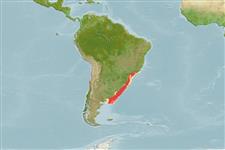Common names from other countries
Classification / Names / Names
Populaire namen | Synoniemen | Catalog of Fishes (gen., sp.) | ITIS | CoL | WoRMS
Environment: milieu / climate zone / depth range / distribution range
Ecologie
; zoetwater; diepteverspreiding 4 - 200 m (Ref. 83435). Tropical, preferred 18°C (Ref. 107945); 23°S - 42°S, 74°W - 42°W
Southwest Atlantic and Southeast Pacific: From Rio de Janeiro, Brazil to San Matiás Gulf, Argentina. In the Pacific it is found in Chile. Tropical to subtropical.
Length at first maturity / Size / Gewicht / Leeftijd
Maturity: Lm ?, range 12 - 13 cm Max length : 27.0 cm DL mannelijk/geslacht niet bekend; (Ref. 83435)
Minimum depth range from Ref. 122063. Lives in shallow waters at maximum depths of 4 m during low tide. Found on sandy subtrates with boulders and sponges. Individuals spend most of their time buried. Females attach their egg capsules to benthic hard substrata such as mollusk shells and/or pebbles (Ref. 122063). Voracious predator on bivalves (Ref. 114777).
Life cycle and mating behavior
Geslachtsrijpheid | Voortplanting | Kuitschieten | Eieren | Fecundity | Larven
This species is a non-broadcast spawner. Life cycle does not include trocophore stage. Also Ref. 833.
SAUP Database. 2006. (Ref. 356)
Status op de Rode Lijst van het IUCN (Ref. 130435)
Status bij CITES (Ref. 108899)
Not Evaluated
Not Evaluated
Gebruik door de mens
Visserij: commercieel
FAO - Visserij: landings | FishSource | Sea Around Us
Tools
Internet-bronnen
Estimates based on models
Preferred temperature
(Ref.
115969): 19.5 - 21.2, mean 20 (based on 9 cells).
Weerstandsvermogen
Gemiddeld, minimale populatieverdubbelingstijd 1,4-4,4 jaar (K=0.21; tm=8.5).
